Exercises (3202)
Extension and flexion of the legs while seated ► crunch kick
Power
Individual work


Sitting on a chair with your upper body leaning slightly backwards, lift your legs off the floor and bend them (pull your knees towards your body). To hold the position better, hold on to the chair with your hands (e.g. grasp the seat, grip the armrest or cross your arms behind the backrest). From this position, stretch your legs out so that they are pointing diagonally forwards (the further horizontally towards the floor, the more difficult) and bend back into the starting position.
1 (office) chair
Extension and flexion of the legs while seated ► crunch kick / knee in
Power
Individual work
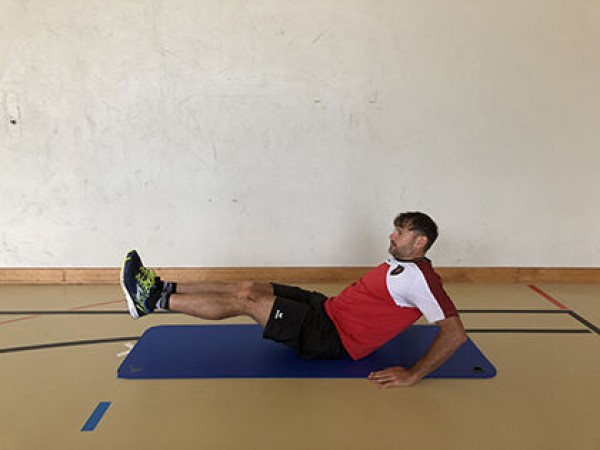

When seated, use your arms to support your upper body, which is leaning slightly backwards, bend your outstretched, raised legs (knees at buttock height) and stretch them forwards back to the starting position (bend and stretch your legs).
Attention:
Do not put your legs down completely.
Lighten:
Just hold the position with slightly bent legs (without stretching the legs), stretch the legs out less.
Harden:
Additional weight on, between or on the legs.
2 weight cuffs/1 weight disc/(medicine) ball/sandbag ► Make the exercise more difficult (additional weight)
Extension and flexion of the legs while seated ► leg press
Power
Individual work
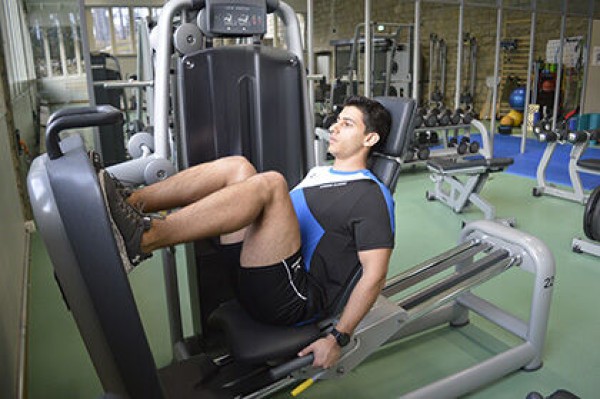

In a slow and controlled movement, press the weight away from the body and then bring it back again.
Starting position:
- Feet rest with the whole sole hip-width apart
- Knee angle is at least 90 degrees
- Back lies flat on the seat (no hollow back)
Finishing position:
- Do not fully extend the knees
- Lower back remains firmly in the seat
- Ankle, knee joint and hip are in line
Attention:
Push the knee outwards (do not allow it to tilt inwards), distribute pressure over the entire foot, do not fall into a hollow back.
Variant I:
The target muscles are changed by changing the position of the feet. The higher the feet are, the more the gluteal muscles are used. If the stance is widened and the feet point outwards, the inner thighs are trained more.
Variant II:
The exercise can also be performed with one leg.
1 weight tower/machine ► leg press
Extension and flexion of the legs while standing (deadlift) ► deadlift
Power
Individual work
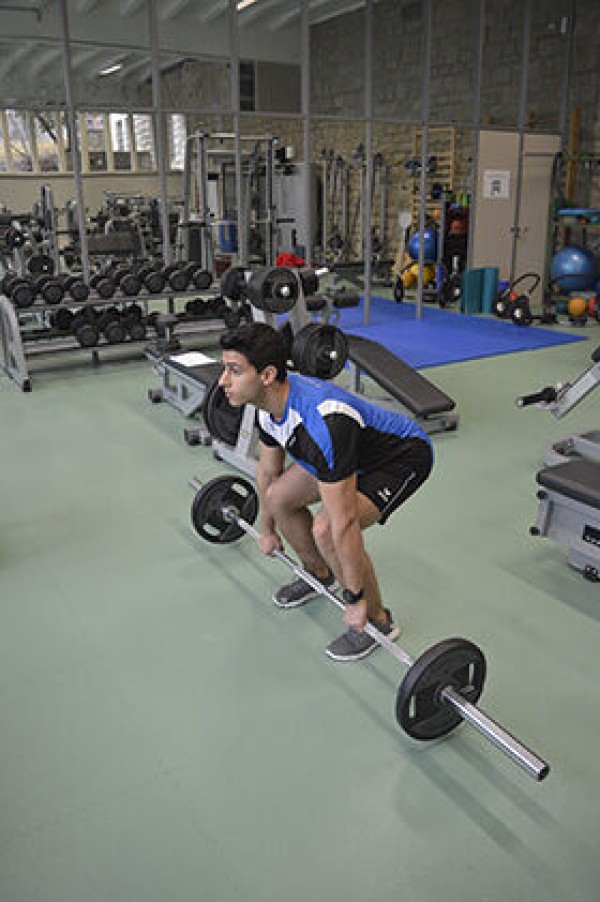

Grab the barbell lying on the floor with an overhand grip (or cross grip) from a squat position, keeping your arms straight and your back straight. By stretching your legs and straightening your upper body, pull the barbell up close to your legs to hip height (arms always straight). Then, when lowering the weight, first bring your hips back and down before bending your knees back to the starting position.
Starting position:
- Squat position, outstretched arms grasp the barbell at shin height, feet under the barbell
- Grasp the barbell shoulder-width apart with an overhand or cross grip
- Back is straight and tense, buttocks pushed back (hip hinge)
- Keep your head straight
Finishing position:
- Stand upright, arms and legs stretched
- Back straight (abdomen tensed)
- Shoulder blades pulled back in a fixed position
Attention:
In the starting position, the floor should be pushed away, creating more tension in the back and buttocks. Never lift the bar with a hunched back, otherwise there is a risk of strain injuries (always keep your back straight). If you are unsure, only train with the bar without (or with little) weight until you have learnt the movement sequence.
1 Langhantel
Extension and flexion of the legs in support ► knee tuck
Power
Individual work

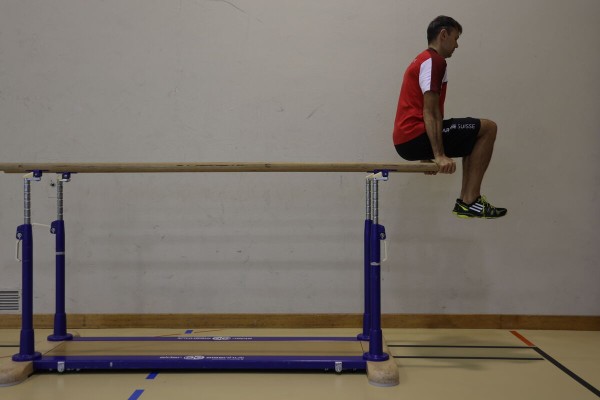
Support yourself on the bar (end), body stretched out, legs pointing (closed) towards the floor, bend both legs at the same time and raise your knees to the height of your belly button. Then stretch your legs back to the starting position (raise and lower your legs).
Attention:
Maintain a stable upper body/arm position during the exercise (elbows close to the body), slightly forward with the upper body, perform the movement in a controlled manner.
Lighten:
Lift your legs less.
Harden:
Add weight (on/between the legs).
Variation:
Bend one leg alternately.
1 parallel bars
2 weight cuffs/1 (medicine) ball/dumbbell ► Make the exercise more difficult (additional weight)
Extension and flexion of the legs in forearm support ► leg press
Power
Individual work
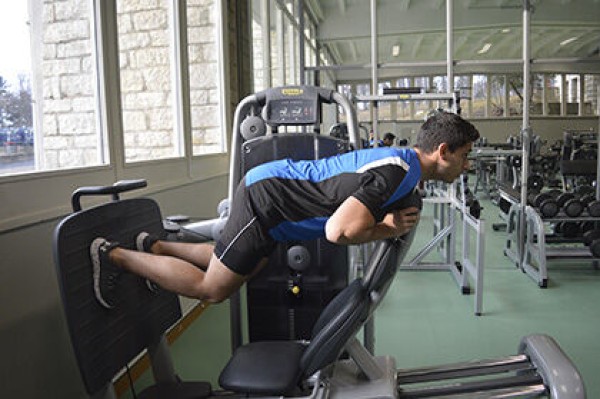

Forearm support on the flat bench, feet on the plate, in a slow and controlled movement, press the weight away from the body and return to the starting position.
Starting position:
- Forearm support on the flat bench (face down)
- Feet are hip-width apart and rest with the entire sole on the footplate
- The knee angle is at least 90 degrees
Finishing position:
- Knees not fully extended
- Back remains straight
- Ankle joint, knee joint and hip are in line
Attention:
Push your knees outwards (do not allow them to tilt inwards), distribute pressure over the whole foot, do not fall into a hollow back.
1 weight tower/machine ► leg press
Extension and flexion of the legs in forearm support ► suspended crunch
Power
Individual work
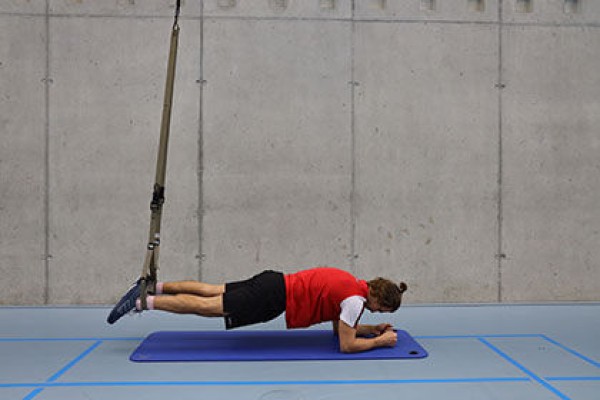

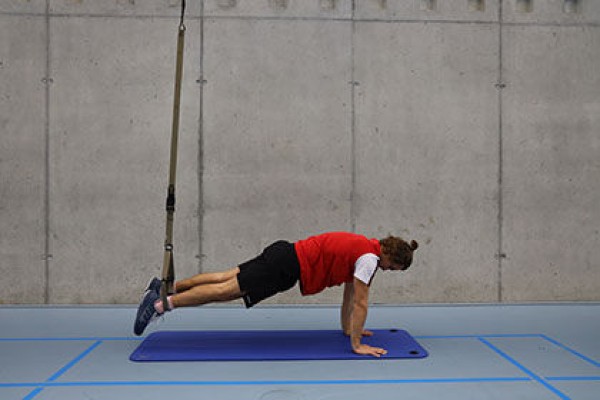
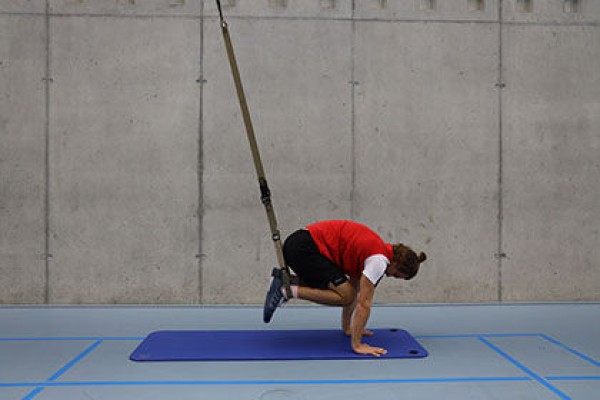

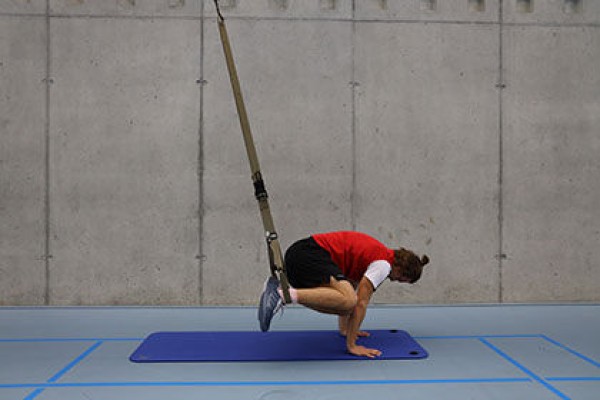
Progression I:
Adjust the sling trainer to mid-lower leg length (standing), support the forearms with the feet vertically under the attachment point in the slings, lift the buttocks and simultaneously pull the knees towards the chest, lower the buttocks and stretch the legs to return to the starting position.
Progression II:
Analogue to progression I, but supported on the hands.
Progression III:
Analogue to progression I, but bring the knees alternately to the left and right elbow.
Progression IV:
Analogue to progression II, but bring the knees alternately to the left and right elbow. In addition, a push-up can be integrated after each repetition.
Attention:
Keep body tension, do not let hips sag, back straight, forearms under shoulders (for all progressions).
Harden:
The further the hands are from the attachment point, the more challenging the exercise becomes.
1 sling trainer
Extension and flexion of the legs in the prone position ► hamstring curls
Power
Individual work
Starting position:
Lie face down on a bench, legs extended. A resistance band is attached to the wall bars and looped around the ankles. Arms extended forward, head in a neutral position.
Movement execution:
From the extended position, bend the knees in a controlled manner, bringing the heels toward the glutes.
Hold briefly, then slowly return to the starting position. Perform the movement smoothly and without momentum.
Attention:
Keep the back stable, avoid arching the lower back. Perform the movement in a controlled manner (no jerky pulls).
Keep the head aligned with the spine.
Lighten:
Use a lighter resistance band.
Harden:
Use a stronger band or add a brief hold at the end of the movement; squeeze the ball with your knees.
1 long bench
1 wall bars
1 resistance band
1 ball ► to make the exercise more challenging
Extension and flexion of the legs in prone position ► lying leg curl
Power
Individual work

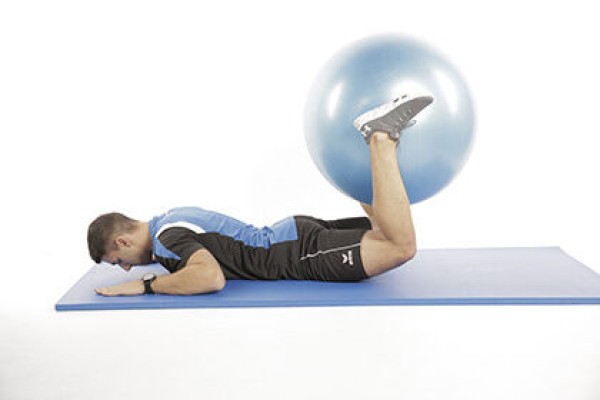
Prone position (upper body slightly raised or flat on the floor), arms bent (elbows approx. 90° at head height or slightly below), clamp the exercise ball between the legs, raise the lower legs (bring the exercise ball to the buttocks) and lower back to the starting position (movement only in the knee joint).
Attention:
Do not lower your legs completely (thigh remains flat on the floor).
Lighten:
Bend your legs less.
Harden:
Add weight to the legs.
1 exercise ball
2 weight sleeves ► to make the exercise more difficult (additional weight)
Extension and flexion of the legs in prone position ► lying leg curl
Power
Individual work
Lying on your stomach on the flat bench, bring your lower legs to your buttocks and back to the starting position in a controlled movement without momentum.
Starting position:
- Prone position, legs almost straight
- The knees are level with the axis of rotation of the machine
- The foot pad is level with the ankle
Finishing position:
- Knees bent, bring the heel towards the buttocks
- The abdomen and hips remain on the pad, the back does not move.
Attention:
Do not arch your back.
Variant:
Perform the exercise on one leg to counteract any muscular imbalance.
1 strength tower/machine ► leg curl
Extension and flexion of the legs in a hanging position ► bent knee leg raise
Power
Individual work

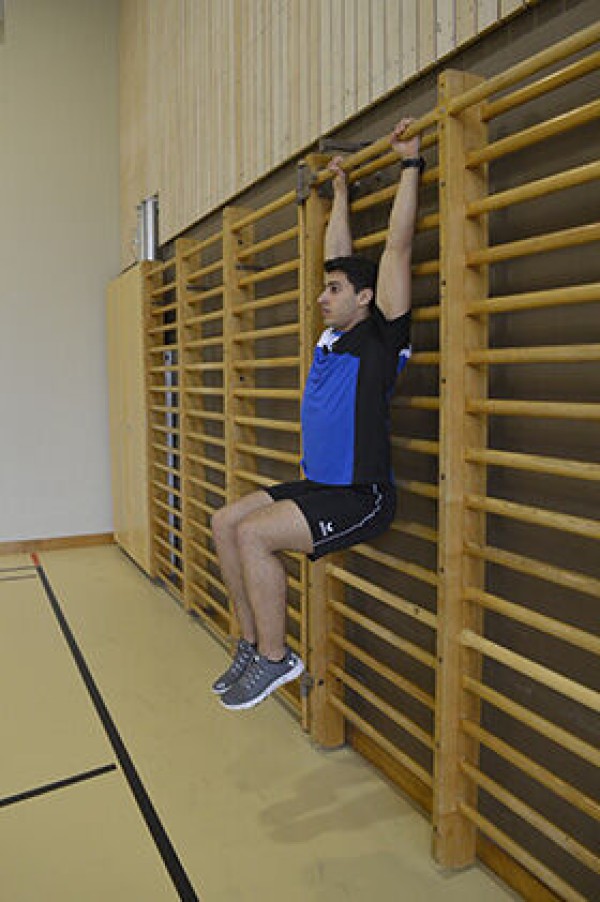
Hanging on the wall bars (back facing the wall bars), body stretched, legs bent and stretched (knees raised to hip height).
Attention:
Back always remains on the wall bars (movement as controlled as possible, without momentum).
Lighten:
Just hold the position with bent legs; lift your knees less high.
Harden:
Additional weight for the legs; stretch the legs.
1 wall bars
2 weight cuffs/1 (medicine) ball (e.g. football, volleyball, basketball) ► Make the exercise more difficult (additional weight)
Extension and flexion of the legs in a hanging position ► bent knee leg raise
Power
Individual work
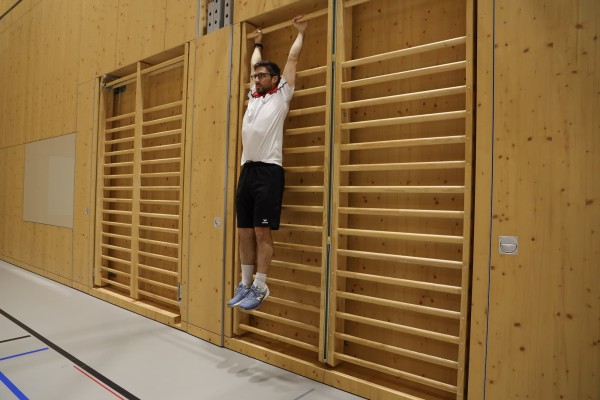

From the hanging position on the wall bars, with the back in contact and the body fully extended, the straight legs are lifted forward in a controlled manner to about hip height and then lowered again. The movement is performed smoothly and without momentum, with the back remaining in constant contact with the wall.
Attention:
Back always remains on the wall bars (movement as controlled as possible, without momentum).
Lighten:
Just hold the position with bent legs; lift your knees less high.
Harden:
Extend the legs; additional weight for the legs; stretch the legs.
1 wall bars
2 weight cuffs/1 (medicine) ball (e.g. football, volleyball, basketball) ► Make the exercise more difficult (additional weight)
Extension and flexion of the legs in a hanging position with weight ► bent knee leg raise
Power
Individual work
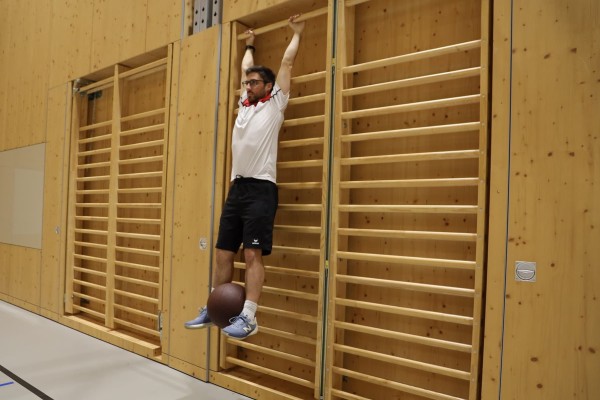
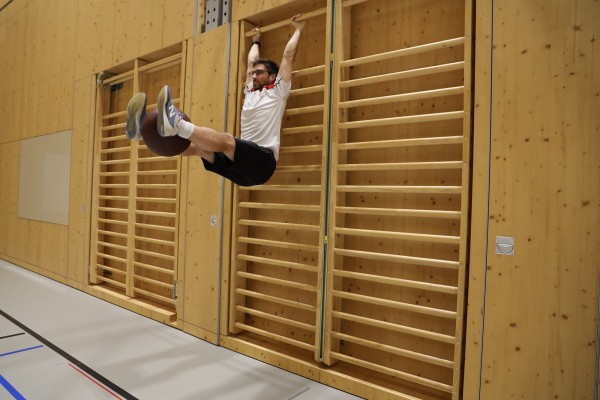
From the hanging position on the wall bars, with the back in contact and the body fully extended, the straight legs loaded with additional weight are lifted forward in a controlled manner to about hip height and then lowered again. The movement is performed smoothly and without momentum, with the back remaining in constant contact with the wall.
Attention:
Back always remains on the wall bars (movement as controlled as possible, without momentum).
Lighten:
Perform the exercise without weight or with a lighter weight.
Harden:
Use more weight for the legs.
1 wall bars
2 weight cuffs/1 (medicine) ball (e.g. football, volleyball, basketball) ► Make the exercise more difficult (additional weight)
Extension and flexion of the legs in push-up position ► suspended crunch
Power
Individual work
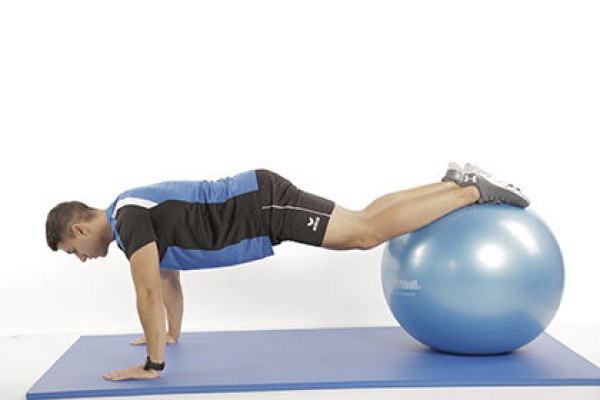
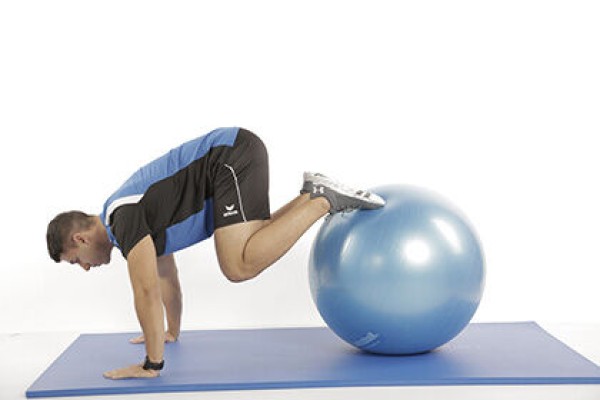
Push-up position, legs placed on the exercise ball, bend legs (bring ball towards body, knees to elbows) and stretch back to starting position.
Attention:
Head, torso, hips and knees practically form a line in the starting position (do not let buttocks sag, tense abdomen), always push hips up.
Lighten:
Just hold the starting position (without bending and stretching the legs); bend the leg less (hardly move the ball towards the body).
Harden:
Additional weight (on the back); unstable support for the arms.
1 exercise ball
1 weight vest/weight disc/sandbag ► to make the exercise more difficult (additional weight)
1 balance cushion/balance board ► to make the exercise more difficult (unstable base)
Extension and flexion of the legs in the supine to shoulder position ► lying tuck shoot out
Power
Individual work
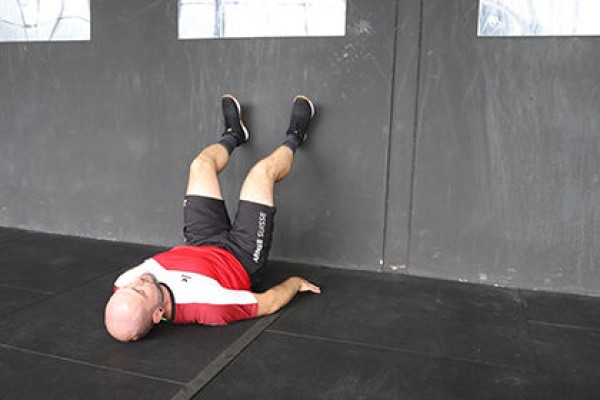
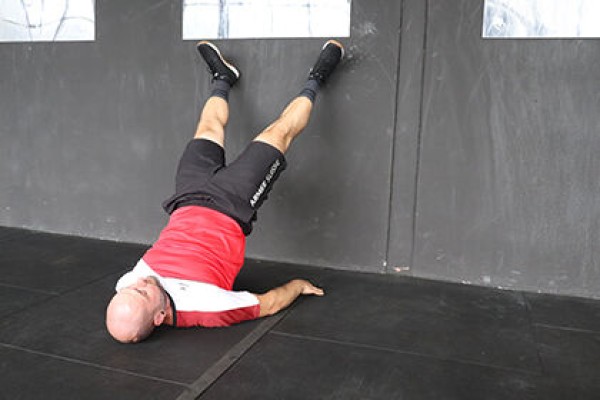
Lying on your back on a soft mat (hands may hold the sides of the mat), legs bent so that the soles of the feet can be pressed against the wall (90 degree angle in the hip and knee joints). From this position, swing your legs upwards to assume the shoulder position (lower back and buttocks lifted off the floor, head remains on the floor), placing your heels against the wall (hold the position briefly). Then lower your legs along the wall and bend them back to the starting position.
Attention:
In the shoulder position, the upper body and legs practically form a line (actively tense the torso).
Lighten:
Only hold the end position in the shoulder position very briefly and lower the body again immediately.
Harden:
Additional weight (on the legs).
1 wall
1 soft mat (small)
2 weight cuffs ► to make the exercise more difficult (additional weight)
Extension and flexion of the legs in supine position
Power
Partner work
1 trainee & 1 helper ► Note change of position
(= double the time required; for lesson planner see Organisation Kraft: Info button Execution)
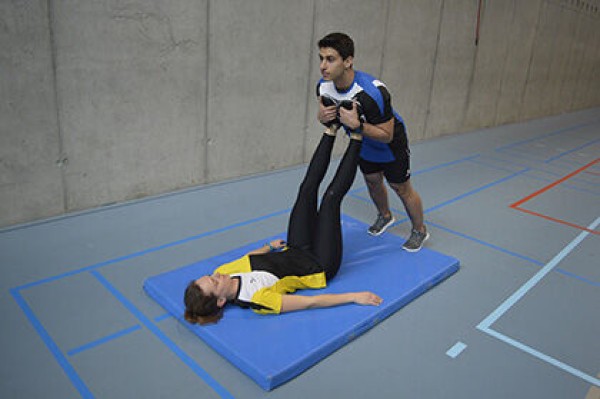
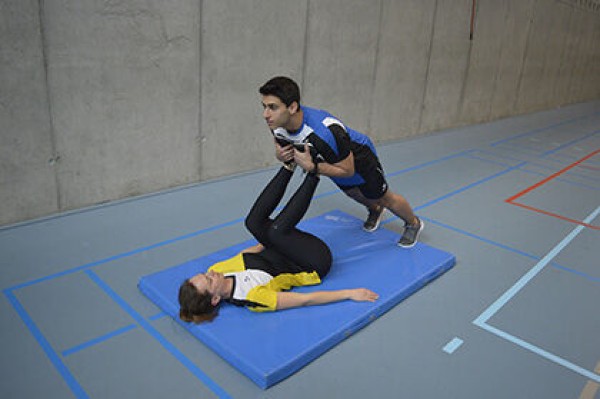
Trainee: Lies on their back with their legs raised and stretched out, hands on the back of their neck or flat on the floor at their sides, bending and stretching their legs to move their partner up and down (leg press).
Partner: Leans from a standing position with their chest on the raised feet (soles of the feet) of the active participant (slight forward lean, good body tension).
Attention:
Knees always remain centred over the feet (no tipping inwards).
Lighten:
The passive participant stands more upright.
Harden:
Stronger partner's submission; additional weight for the passive participant (on the chest or shoulders).
1 weight vest/weight disc/sandbag ► Make the exercise more difficult (additional weight)
Extension and flexion of the legs in supine position
Power
Individual work
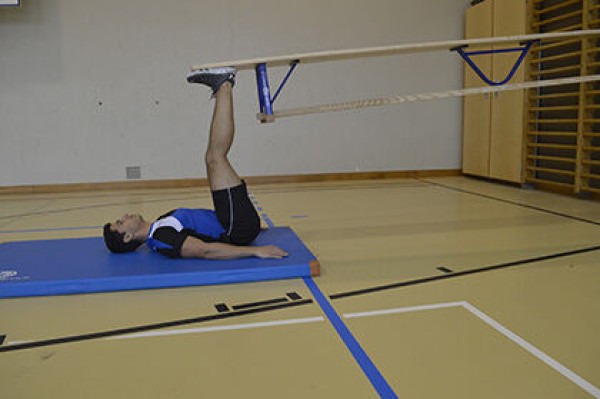
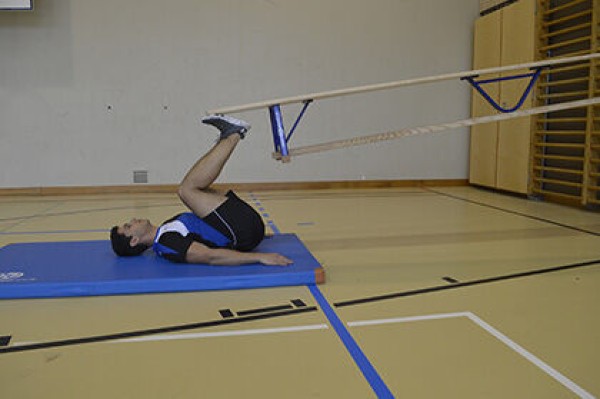
Long bench attached to the wall bars/swinging box, lying on your back on a soft mat, hands stretched out to the side on the floor (grasping the soft mat), feet supporting the free end of the long bench (legs bent, knees pointing towards the chest), legs (almost) fully extended and bent back to the starting position (raise and lower long bench).
Attention:
Do not fully extend legs, put weight on the whole foot.
Lighten:
Bend your legs less.
Harden:
Additional weight (weight disc on the long bench).
Additional weight (one partner sits at the other end of the long bench; the further forward towards the exerciser they move, the greater the weight to be lifted) - organisation = partner work.
1 vaulting box or wall bars
1 long bench
1 soft mat (small)
1 weight disc/sandbag ► to make the exercise more difficult (additional weight)
Extension and flexion of the legs in supine position ► bent leg raise
Power
Individual work
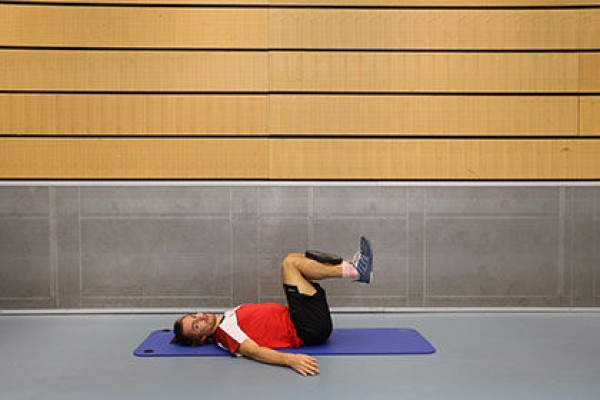
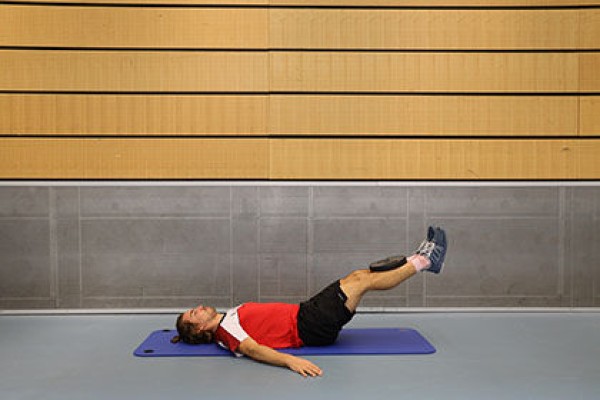
Lie on your back with your legs stretched out from the floor, a weight disc on your shins, arms stretched out to the side on the floor, bend your legs (approximately right angle at the knee joint, knees at buttock height) and stretch back to the starting position. Always hold the position with your legs stretched for a few seconds (4-8) before bringing your legs back again.
Attention:
Keep your back in contact with the floor (consciously tense your abdomen).
Lighten:
Extend your legs less; lift your legs further off the floor; only hold the position with your legs extended for a short time; no additional weight on your shins.
Harden:
More weight; hold the position with your legs extended for longer.
1 weight disc
Extension and flexion of the legs in supine position ► crunch kick
Power
Individual work
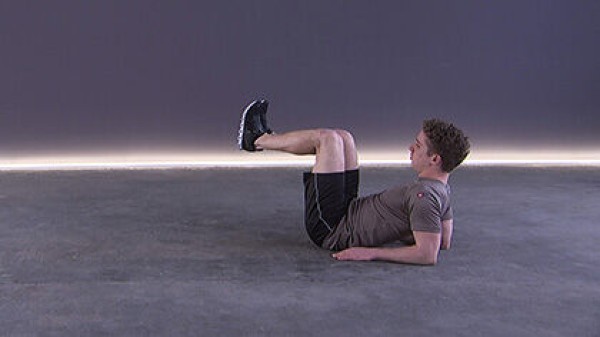

Back position, bent arms support the slightly raised upper body (forearms flat on the floor), bend the legs (knees at buttock height) and stretch forwards back to the starting position.
Attention:
Do not put your legs down completely, in the variations with the upper body lowered: Keep your (lower) back in constant contact with the floor (consciously tense your abdomen).
Lighten:
Just hold the position with slightly bent legs (without stretching your legs), stretch your legs less.
Harden:
Additional weight on, between or on top of the legs.
Variant I:
Upper body flat on the floor, arms stretched out to the sides on the floor.
Variant II:
Upper body flat on the floor, arms stretched out to the side on the floor, legs bent and stretched and then pushed out straight up by lifting the pelvis.
2 weight cuffs/1 weight disc/(medicine) ball/sandbag ► Make the exercise more difficult (additional weight)
Extension and flexion of the legs in supine position ► crunch kick / knee crunch
Power
Individual work

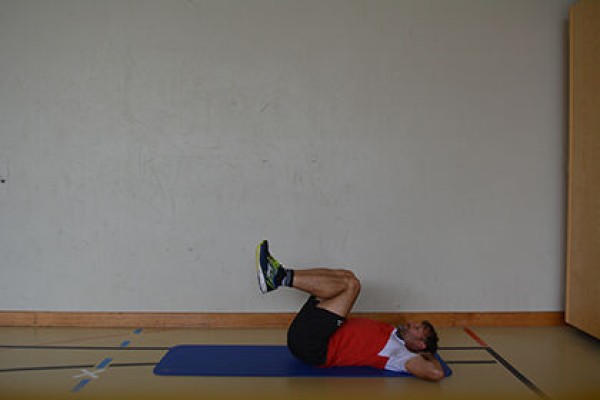
Back position, upper body flat on the floor, arms stretched out to the sides on the floor (or place hands under the buttocks / or clasp hands behind the head), bend legs (knees at buttock height) and stretch back to the starting position in front (bend and stretch legs).
Attention:
Do not put your legs down completely, keep your (lower) back in constant contact with the floor (consciously tense your abdomen).
Lighten:
Just hold the position with slightly bent legs (without stretching your legs), stretch your legs less.
Harden:
Additional weight on, between or on top of your legs.
2 weight cuffs/1 weight disc/(medicine) ball/sandbag ► Make the exercise more difficult (additional weight)
Extension and flexion of the legs in supine position ► leg curl
Power
Individual work

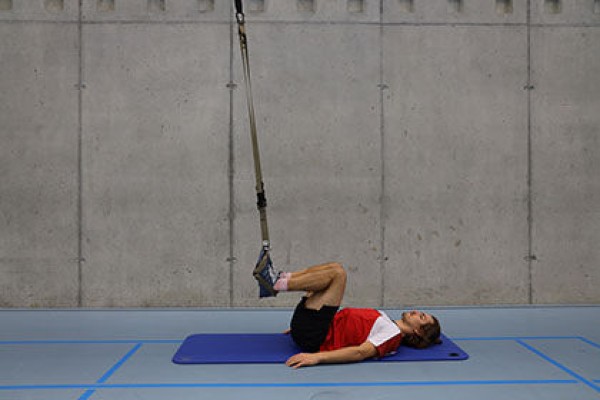
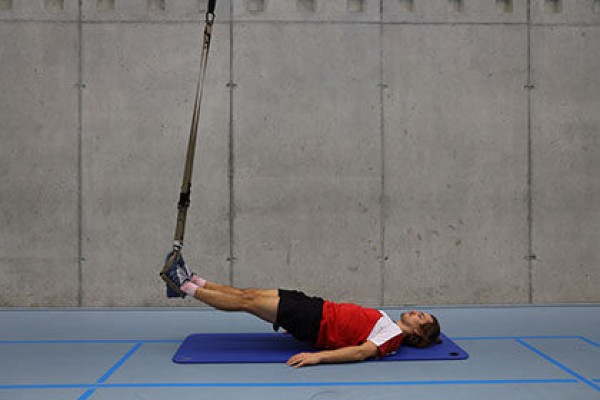
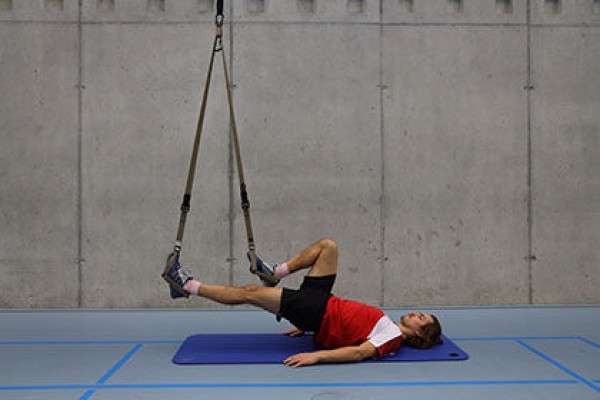



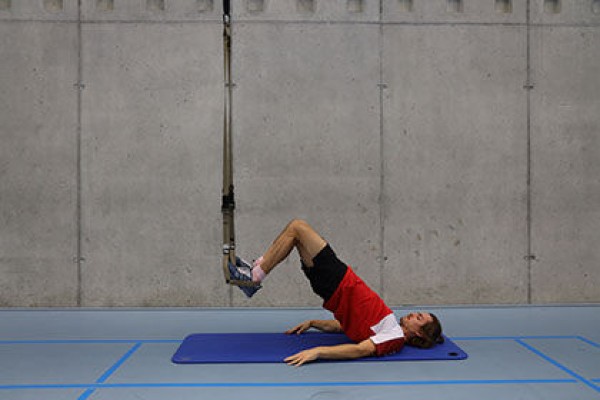
Progression I:
Adjust the sling trainer to mid-lower leg length (standing), lie on your back with your face up, fix your heels in the slings vertically below the attachment point, pull your heels towards your buttocks and return to the starting position. Press the heels down during the entire movement.
Progression II:
Analogue to progression I, but the pelvis is lifted off the floor (body tension, only the shoulders rest on the floor), alternately pull one leg up.
Progression III:
Analogue to progression II, but both legs are pulled up at the same time. When pulling the heels up, lift the pelvis and form a right angle with the knees.
Progression IV:
Analogue to progression III, still supine, but in the starting position the heels are not vertically under the attachment point but are closer to the body (sling trainer hangs at an angle and points towards the body), in addition the arms are stretched out in front (pointing upwards). The further away the head is from the attachment point, the more challenging the exercise becomes.
1 sling trainer
Extension and flexion of the legs in supine position ► leg press
Power
Individual work
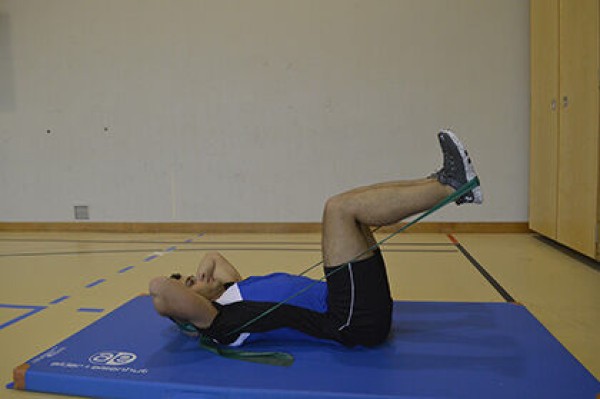

Lying on your back, legs bent in a high position with a right angle at the knee joint (lower legs parallel to the floor), centre of the band wrapped around the soles of your feet, grasp the ends of the band with your hands and place them on the back of your neck (elbows pointing outwards/to the side), stretch and bend your legs.
Attention:
Keep your back in constant contact with the floor.
Lighten:
Choose a rubber band with less resistance.
Harden:
Choose a rubber band with more resistance.
1 elasticated rubber band
Extension and flexion of the legs in shoulder position ► hamstring curl
Power
Individual work
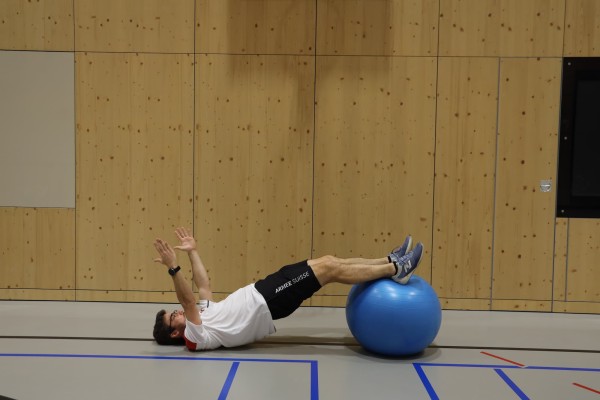
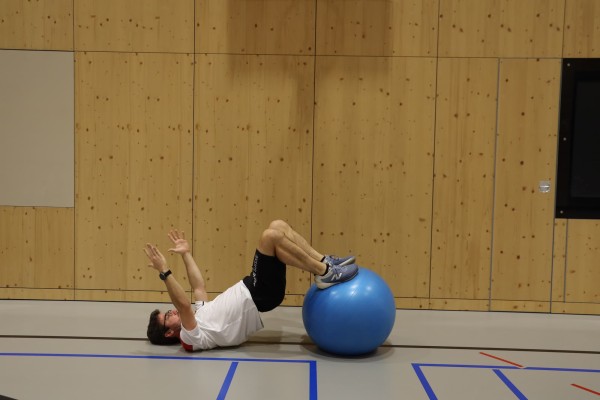
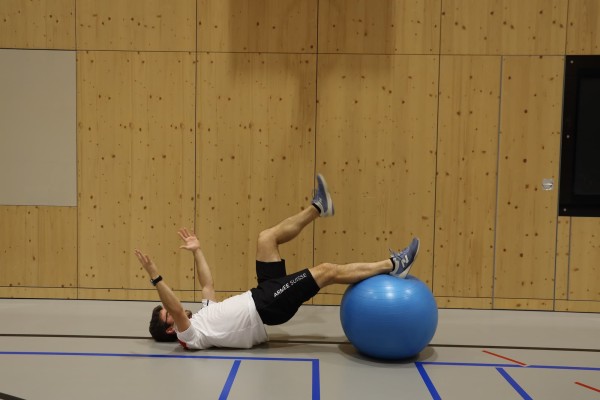
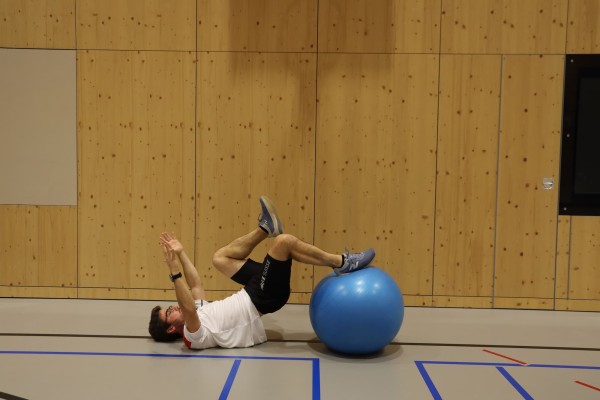
Shoulder position with legs stretched out on the exercise ball, arms raised to the sides, push hips up, bend legs (bring exercise ball to buttocks) and stretch back to starting position.
Attention:
Torso, hips and knees practically form a line in the starting position (do not let buttocks sag, push hips up, tense abdomen).
Lighten:
Just hold the position (without bending and stretching your legs), bend your legs less (hardly move the ball towards your body).
Harden:
Pull the gym ball toward the glutes with one leg; hold additional weight with your hands on your hips.
1 exercise ball
1 weight disc/dumbbell/sandbag ► Make the exercise more difficult (additional weight)
Extension and flexion of the legs in shoulder position ► hamstring curl
Power
Individual work
Lying on the back, place the heels on a sliding towel. The arms are extended vertically upwards. Lift the hips so that the trunk, hips, and knees form a straight line. Then bend the legs and pull the towel towards the glutes in a controlled manner. Afterwards, extend the legs again and return to the starting position. The hips remain lifted throughout the entire movement.
Attention:
The trunk, hips, and knees should form a nearly straight line in the starting position (do not let the hips drop, engage the core, actively push the hips upward). Perform the movement smoothly and in a controlled way, without momentum. Bend the legs only as far as body tension can be maintained.
Lighten:
Work without a towel: from the same position, take small, slow steps with the feet backward and then forward; simply hold the position (static glute bridge); bend the legs less.
Harden:
Perform the exercise on one leg: one leg remains extended while the other pulls the towel toward the glutes; slow down the tempo or include a brief hold when the legs are bent; place additional weight on the hips.
1 sliding towel
1 weight disc/dumbbell► Make the exercise more difficult (additional weight)
Extension and flexion of the legs in shoulder position ► leg curl
Power
Individual work

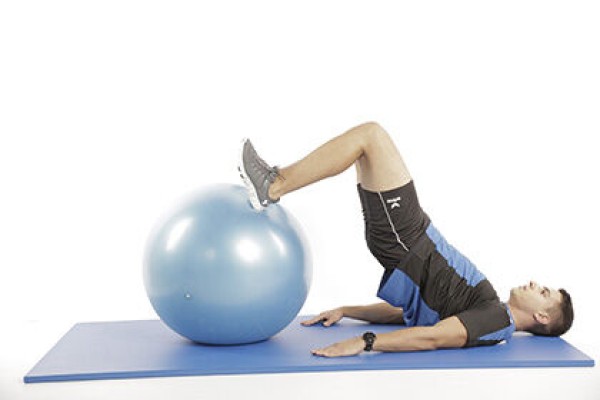
Shoulder position with legs stretched out on the exercise ball, arms resting at the sides on the floor, push hips up, bend legs (bring exercise ball to buttocks) and stretch back to starting position.
Attention:
Torso, hips and knees practically form a line in the starting position (do not let buttocks sag, push hips up, tense abdomen).
Lighten:
Just hold the position (without bending and stretching your legs), bend your legs less (hardly move the ball towards your body).
Harden:
Do not lay your arms flat on the floor, but cross them in front of your chest; hold additional weight with your hands on your hips.
1 exercise ball
1 weight disc/dumbbell/sandbag ► Make the exercise more difficult (additional weight)